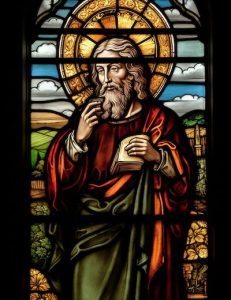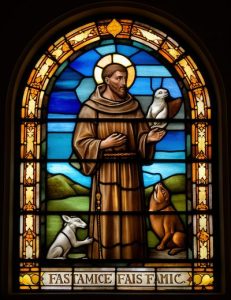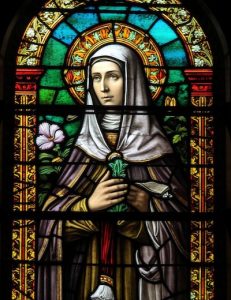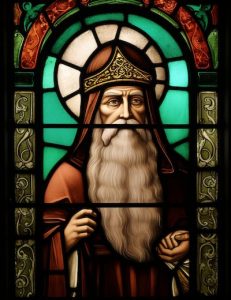Introduction to serving God with a disability
The history of Christianity is filled with stories of perseverance, faith, and resilience. Among these are tales of saints who, despite their physical or mental disabilities, demonstrated serving God with a disability and made significant contributions to the Church and the lives of its believers. This blog highlights their journeys and how they turned perceived limitations into spiritual strengths.
St. Paul the Apostle: Faith Beyond Physical Limitations
 The transformative tale of Saul’s journey from a persecutor of Christians to becoming St. Paul the Apostle is a cornerstone of Christian history. Revered for his extensive contributions to the New Testament and his unwavering dedication to the teachings of Jesus Christ, Paul’s life is marked by fervent faith, prolific writings, and missionary journeys.
The transformative tale of Saul’s journey from a persecutor of Christians to becoming St. Paul the Apostle is a cornerstone of Christian history. Revered for his extensive contributions to the New Testament and his unwavering dedication to the teachings of Jesus Christ, Paul’s life is marked by fervent faith, prolific writings, and missionary journeys.
A series of narratives suggests that Paul may have lived with a physical disability. Delving into these theories and examining their evidence offers a fresh and insightful perspective on the Apostle’s story—one that further elevates his achievements.
Several New Testament and early Christian literature passages hint at Paul’s physical afflictions. In his own letters, Paul frequently referred to a “thorn in the flesh” (2 Corinthians 12:7). Though the precise nature of this ‘thorn’ remains ambiguous, its recurrent mention paints a picture of a man grappling with a persistent ailment. Some biblical scholars speculate this mysterious ‘thorn’ might metaphorically represent a genuine physical disability.
Two primary theories emerge: Paul had a speech impediment and a hearing impairment or was lame. Galatians 4:13-14 provides a glimpse into this line of thought: “You know that it was because of a bodily ailment that I preached the gospel to you at first, and though my condition was a trial to you, you did not scorn or despise me, but received me as an angel of God, as Christ Jesus.” The scripture suggests a noticeable bodily condition, leading to speculations of visible physical impairments.
Further supporting the theory of a speech impediment is the description of Paul in the second-century “Acts of Paul,” where he’s characterized as having a “bald head” and “bow-legged” stature, with a “well-built physique,” but also “a crooked nose” and “speech impediment.” This speech impediment hypothesis is complemented by comments from his critics, who sometimes derogatorily pointed out Paul’s “contemptible speech” (2 Corinthians 10:10).
But, irrespective of the exact nature of his disability, what remains evident is that any physical limitations did not deter Paul’s mission. If anything, these challenges served to amplify the strength of his faith and the depth of his commitment to Christ. He traveled extensively, faced numerous perils, and engaged with diverse communities. His epistles, filled with theological insights and pastoral care, remain central to Christian teachings today.
Paul’s perseverance, particularly if viewed through the lens of physical impairment, becomes even more awe-inspiring. It elucidates a man who, rather than being constrained by his disabilities, utilized them as a testament to the power of faith. His life story stands as a beacon of hope, underscoring that it is not our physical abilities but our faith and spirit that determine our path and providing examples of serving God with a disability.
St. Francis of Assisi: Embodying Divine Love and Compassion
 Saint Francis of Assisi, the revered patron saint of animals and ecology, is an iconic figure in Christian history’s annals. His profound love and compassion for all living beings made him an embodiment of Christ’s teachings, transcending human biases to extend his warmth even to the most marginalized, including those with disabilities.
Saint Francis of Assisi, the revered patron saint of animals and ecology, is an iconic figure in Christian history’s annals. His profound love and compassion for all living beings made him an embodiment of Christ’s teachings, transcending human biases to extend his warmth even to the most marginalized, including those with disabilities.
His teachings were deeply entrenched in the belief that everyone bore God’s image irrespective of their physical or mental capacities. Such a philosophy rendered all beings worthy of unwavering dignity, respect, and love. His life is peppered with numerous tales that illustrate these beliefs. Among the many legends associated with him, one narrates the miraculous healing of a man born blind. It’s said that through his prayers and faith, Saint Francis brought vision to the blind man, emphasizing the saint’s spiritual prowess and divine compassion.
Francis’s unique connection with the animal kingdom also holds legendary status. There are numerous accounts of him communicating with animals, from preaching to birds to taming a fierce wolf. For St. Francis, this wasn’t just a demonstration of spiritual charisma but a profound testament to his belief in the divine essence present in all creatures. In his eyes, every living entity, human or animal, bore witness to God’s creation, deserving of reverence and protection.
Beyond his legendary feats and spiritual teachings, Saint Francis, too, grappled with health issues in his personal life. In his later years, he suffered from a severe eye ailment, which is believed to have been trachoma, causing him immense pain and gradual blindness. Yet, despite his personal afflictions, Saint Francis continued his mission, radiating love, hope, and inspiration.
His life serves as a beacon, with unyielding compassion, humility, and a deep-seated reverence for God’s creations. Through his actions and teachings, Saint Francis of Assisi underscores the message that true divinity lies in recognizing and honoring the divine spark in every being.
Blessed Margaret of Castello: Triumph of Spirit Over Adversity
 Blessed Margaret of Castello is a testament to the resilience of the human spirit and the power of unwavering faith. Born in 1287 into a noble family in Italy, Margaret’s life was immediately marked by profound challenges. From birth, she grappled with many health issues: she was born blind, with a severe curvature of the spine that resulted in dwarfism, and she also had difficulties with mobility, causing her to limp. These disabilities, though formidable, never defined her spirit or determination.
Blessed Margaret of Castello is a testament to the resilience of the human spirit and the power of unwavering faith. Born in 1287 into a noble family in Italy, Margaret’s life was immediately marked by profound challenges. From birth, she grappled with many health issues: she was born blind, with a severe curvature of the spine that resulted in dwarfism, and she also had difficulties with mobility, causing her to limp. These disabilities, though formidable, never defined her spirit or determination.
Margaret’s early life was marked by rejection and isolation. Her family, unable to cope with her disabilities and the societal stigma they carried, chose to hide her from the public eye. For years, she lived secluded in a small room adjoining a chapel. Yet, even in such confinement, Margaret’s spirit remained indomitable. She found solace in her faith, developing a deep spiritual connection and understanding that would lay the foundation for her future.
In a heartbreaking twist, when Margaret was in her late teens, her parents, still seeking a miraculous cure for her ailments, abandoned her in the streets of Citta di Castello when their hopes went unfulfilled. However, instead of breaking Margaret, this abandonment began her true mission. The townspeople of Citta di Castello, witnessing her deep faith and resilience, welcomed her.
Margaret dedicated her life to service, turning her suffering into a conduit for compassion. She became a Dominican tertiary, providing counsel, comfort, and aid to the sick, poor, and needy. Her presence became synonymous with hope and solace. Despite her physical limitations, she tirelessly visited prisons, cared for the destitute, and became an inspirational figure to many.
Blessed Margaret of Castello’s life is a compelling reminder of the innate strength of the human spirit. Rather than succumbing to bitterness due to her hardships, she transformed her pain into a life of serving God with a disability, leaving an indelible mark on all she touched.
Venerable Herman of Alaska: A Beacon in the Wilderness while serving God with a disability
 Venerable Herman of Alaska stands as a beacon of faith and service, especially in the harsh terrains and climates of the Alaskan frontier. Born in the 18th century in Russia, Herman chose monastic life early on, becoming a monk at the Valaam Monastery on Lake Ladoga. But his mission to Alaska would come to define his legacy.
Venerable Herman of Alaska stands as a beacon of faith and service, especially in the harsh terrains and climates of the Alaskan frontier. Born in the 18th century in Russia, Herman chose monastic life early on, becoming a monk at the Valaam Monastery on Lake Ladoga. But his mission to Alaska would come to define his legacy.
Upon his arrival in the Kodiak Archipelago as part of a mission to evangelize the native peoples, Herman was met with both the rugged beauty of the North American wilderness and its accompanying challenges. Among these challenges were the health issues that Herman faced. He bore physical disabilities that some sources suggest might have made him immobile or severely limited his movement. However, the precise nature of his disability remains shrouded in mystery.
Yet, this did not deter Herman from his spiritual and humanitarian mission. Recognizing the often harsh treatment of the indigenous Aleut people by colonial Russian forces, Herman became their protector, advocate, and spiritual guide. He often confronted the colonial authorities, defending the rights and dignity of the native inhabitants.
Beyond advocacy, Herman provided tangible services. He established a school for the Aleut children, where they learned about Christianity and were taught essential life skills. Recognizing the importance of self-sufficiency, he also introduced advanced farming techniques, helping to sustain and nourish the local communities.
Herman’s hermitage on Spruce Island became a center of spirituality and solace for many. Despite his physical ailments, his spiritual strength seemed boundless. He often provided counsel, comforted the sick, and was revered as a healer by the Aleuts.
Venerable Herman of Alaska’s life story is a testament to the transformative power of faith and resilience. While physically limited, his spirit knew no bounds. Through tireless service and advocacy, he illuminated the lives of the indigenous peoples of Alaska, ensuring they found a voice and place within the tapestry of Christian history and provided us with additional examples of serving God with a disability.
Please leave a comment about your thoughts.
Click here for additional information about this site.
Click here to learn more about Lifehouse Adelaide.
